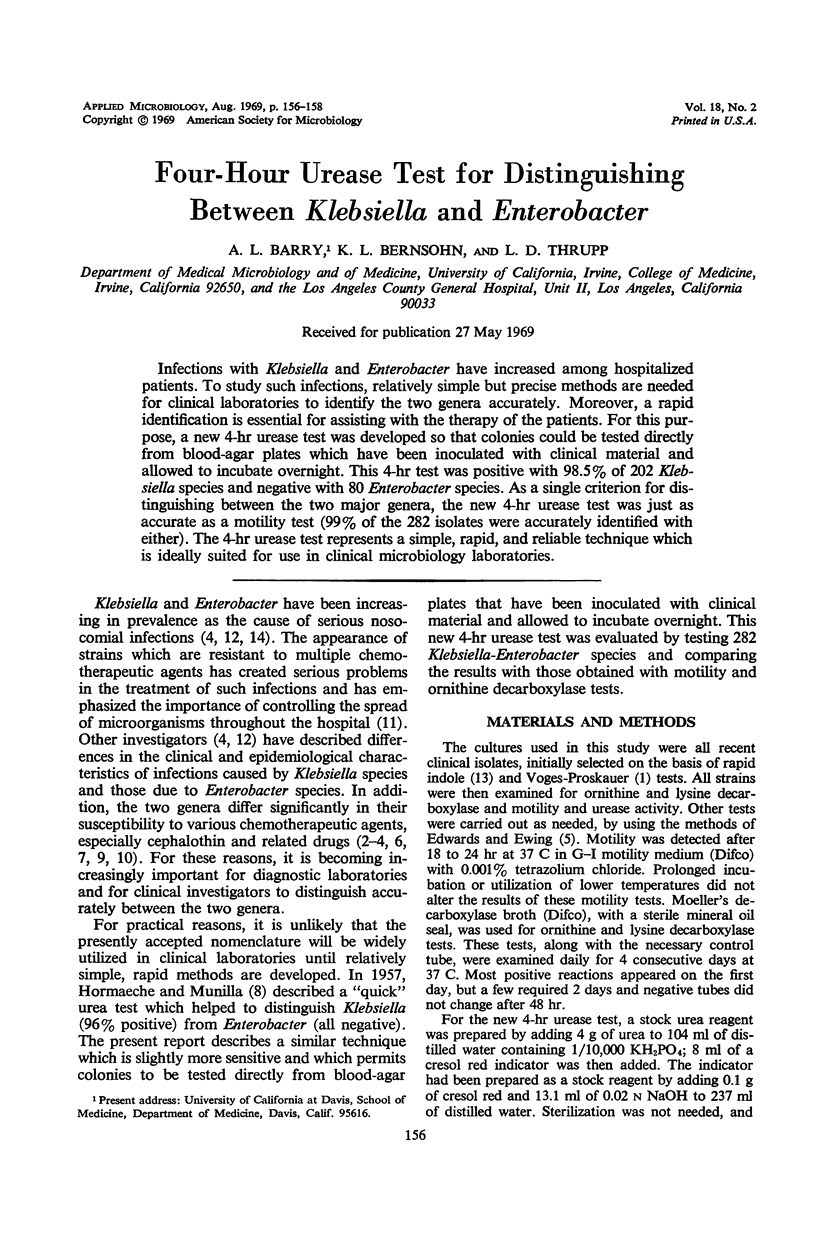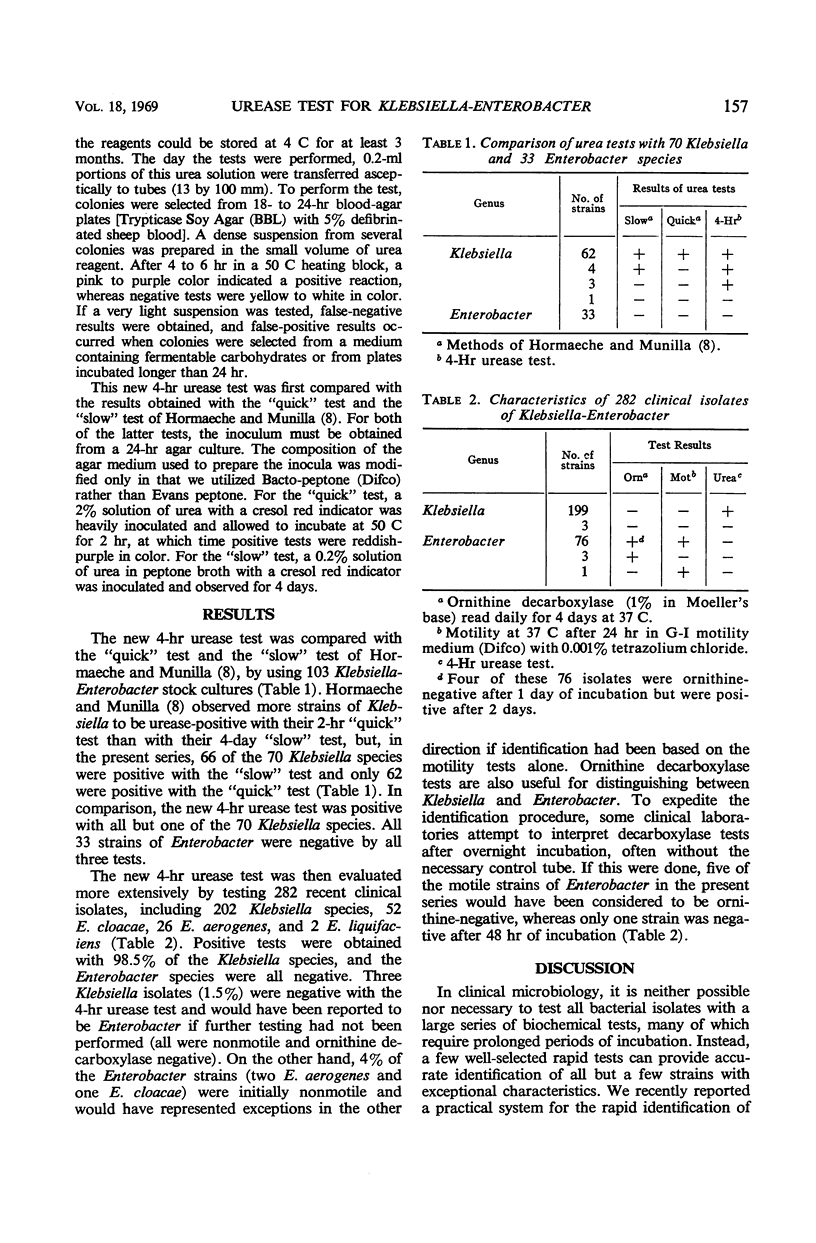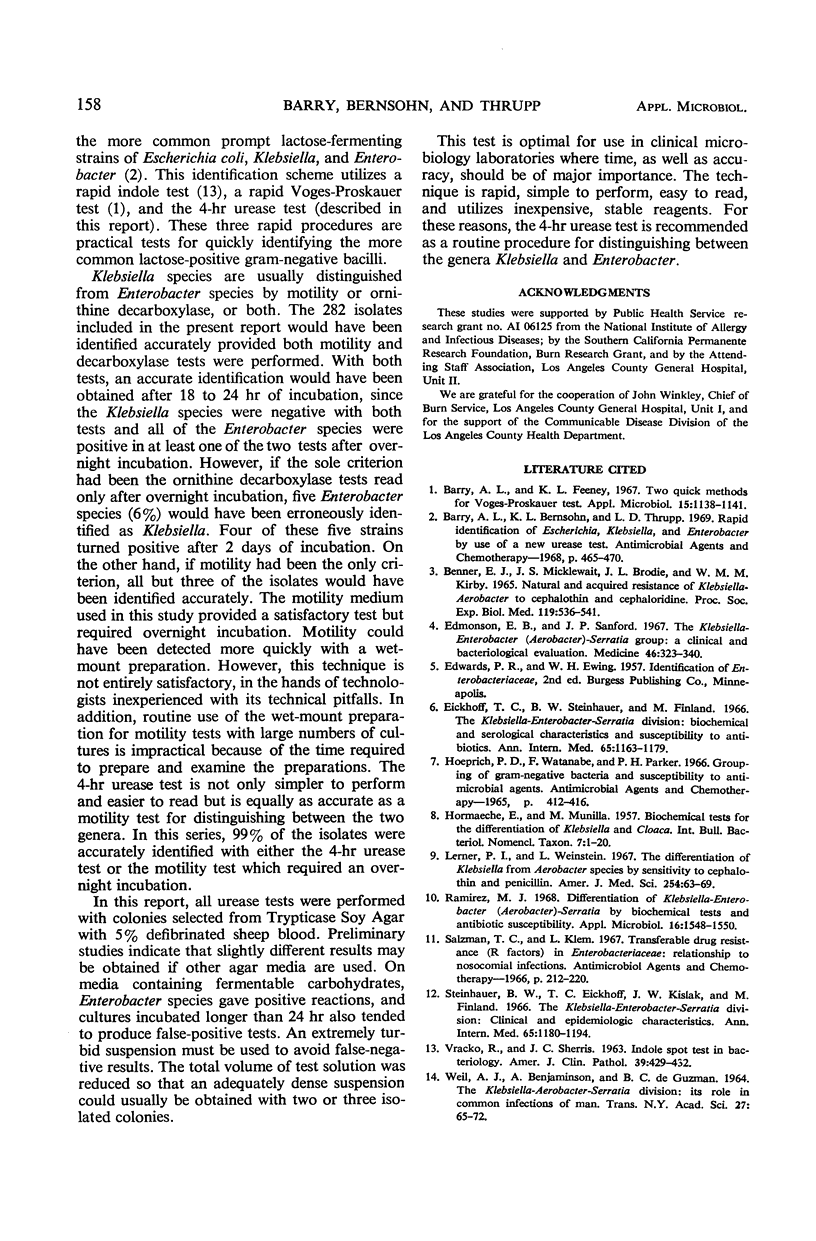Abstract
Infections with Klebsiella and Enterobacter have increased among hospitalized patients. To study such infections, relatively simple but precise methods are needed for clinical laboratories to identify the two genera accurately. Moreover, a rapid identification is essential for assisting with the therapy of the patients. For this purpose, a new 4-hr urease test was developed so that colonies could be tested directly from blood-agar plates which have been inoculated with clinical material and allowed to incubate overnight. This 4-hr test was positive with 98.5% of 202 Klebsiella species and negative with 80 Enterobacter species. As a single criterion for distinguishing between the two major genera, the new 4-hr urease test was just as accurate as a motility test (99% of the 282 isolates were accurately identified with either). The 4-hr urease test represents a simple, rapid, and reliable technique which is ideally suited for use in clinical microbiology laboratories.
Full text
PDF


Selected References
These references are in PubMed. This may not be the complete list of references from this article.
- BENNER E. J., MICKLEWAIT J. S., BRODIE J. L., KIRBY W. M. NATURAL AND ACQUIRED RESISTANCE OF KLEBSIELLA-AEROBACTER TO CEPHALOTHIN AND CEPHALORIDINE. Proc Soc Exp Biol Med. 1965 Jun;119:536–541. doi: 10.3181/00379727-119-30231. [DOI] [PubMed] [Google Scholar]
- Barry A. L., Bernhn K. L., Thrupp L. D. Rapid identification of Escherichia, Klebsiella, and Enterobacter by use of a new urease test. Antimicrob Agents Chemother (Bethesda) 1968;8:465–470. [PubMed] [Google Scholar]
- Barry A. L., Feeney K. L. Two quick methods for Voges-Proskauer test. Appl Microbiol. 1967 Sep;15(5):1138–1141. doi: 10.1128/am.15.5.1138-1141.1967. [DOI] [PMC free article] [PubMed] [Google Scholar]
- Edmondson E. B., Sanford J. P. The Klebsiella-Enterobacter (Aerobacter)-Serratia group. A clinical and bacteriological evaluation. Medicine (Baltimore) 1967 Jul;46(4):323–340. doi: 10.1097/00005792-196707000-00002. [DOI] [PubMed] [Google Scholar]
- Eickhoff T. C., Steinhauer B. W., Finland M. The Klebsiella-Enterobacter-Serratia division. Biochemical and serologic characteristics and susceptibility to antibiotics. Ann Intern Med. 1966 Dec;65(6):1163–1179. doi: 10.7326/0003-4819-65-6-1163. [DOI] [PubMed] [Google Scholar]
- Hoeprich P. D., Watanabe F., Parker R. H. Grouping of gram-negative bacteria and susceptibility to antimicrobial agents. Antimicrob Agents Chemother (Bethesda) 1965;5:412–416. [PubMed] [Google Scholar]
- Lerner P. I., Weinstein L. The differentiation of Klebsiella from Aerobacter species by sensitivity to cephalothins and penicillins. Am J Med Sci. 1967 Jul;254(1):63–68. doi: 10.1097/00000441-196707000-00007. [DOI] [PubMed] [Google Scholar]
- Ramirez M. J. Differentiation of Klebsiella-Enterobacter (Aerobacter)-Serratia by biochemical tests and antibiotic susceptibility. Appl Microbiol. 1968 Oct;16(10):1548–1550. doi: 10.1128/am.16.10.1548-1550.1968. [DOI] [PMC free article] [PubMed] [Google Scholar]
- Salzman T. C., Klemm L. Transferable drug resistance (R factors) in Enterobacteriaceae: relationship to nosocomial infections. Antimicrob Agents Chemother (Bethesda) 1966;6:212–220. [PubMed] [Google Scholar]
- Steinhauer B. W., Eickhoff T. C., Kislak J. W., Finland M. The Klebsiella-Enterobacter-Serratia division. Clinical and epidemiologic characteristics. Ann Intern Med. 1966 Dec;65(6):1180–1194. doi: 10.7326/0003-4819-65-6-1180. [DOI] [PubMed] [Google Scholar]
- WEIL A. J., BENJAMINSON M. A., DEGUZMAN B. C. THE KLEBSIELLA-AEROBACTER-SERRATIA DIVISION: ITS ROLE IN COMMON INFECTIONS OF MAN. Trans N Y Acad Sci. 1964 Nov;27:65–72. doi: 10.1111/j.2164-0947.1964.tb03487.x. [DOI] [PubMed] [Google Scholar]


